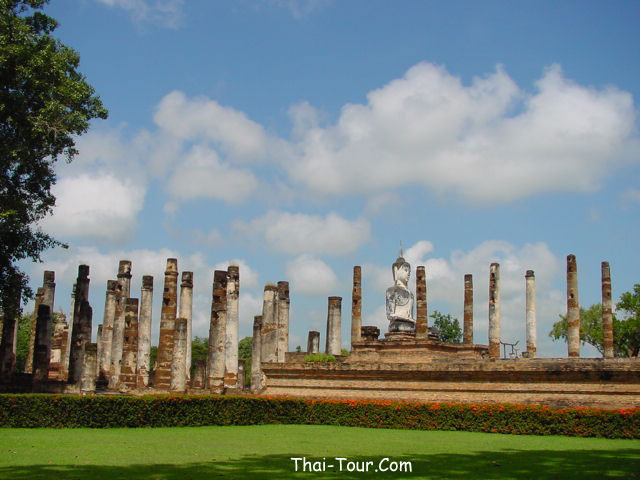|
|
|
|
|
The Royal Palace and Wat Mahathat, Sukho, Sukhothai
|
| |
The royal palace lies in the center of the town and covers an area of 160,000 square meters. This area is surrounded by a moat and contains two main compounds; the royal building and the sanctuary in the palace. In the royal compound exists the ruins of the royal building called Noen Phrasat.
Here, the famous stone inscription of King Ramkhamhaeng was found by King Mongkut (Rama IV) in the 19th century together with a piece of the stone throne called "Manangkhasila Asana" King Ramhamhaeng set up the throne in the midst of a sugar palm grove where, at his request, a monk preached on Buddhist Sabbath days and the King conducted the affairs of state on other days This throne was later installed in Bangkok's Temple of the Emerald Buddha. A sanctuary lying to the west behind the Royal Palace compound is Wat Mahathat. It is Sukhothai's largest temple with a customary main Chedi in lotus-bud shape and a ruined viharn. At the base of the Chedi stands Buddhist disciples in adoration, and on the pedestal are seated Buddha images. In front of this reliquary is a large viham formerly containing a remarkable seated bronze Buddha image of the Sukhothai style, which was cast and installed by King Lithai of Sukhothai in 1362. At the end of the 18th century, the image was removed to the Viham Luang of Wat Suthat in Bangkok by the order of King Rama I and has since been named Phra Si Sakaya Muni. In front of the large viharn is another smaller viham which was probably built during the Ayutthaya period. Its main Buddha image (8 meters high) was installed inside a separate building. In front of the southern image, a piece of sculpture called, "Khom Dam Din" (a Khmer who come by way of walking underground) was found, and is now kept in the Mae Ya Shrine near the Sukhothai City Hall. On the South stands a pedestal of a large Chedi built up in steps, the lowest platform is adorned with beautiful stucco figures of demons, elephants and lions with angles riding on their backs. Mural painting adorn this Chedi.
|

|
|
|
|
|
|
|
 |
 |
 |
|